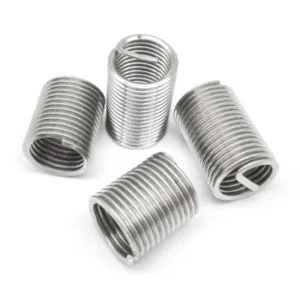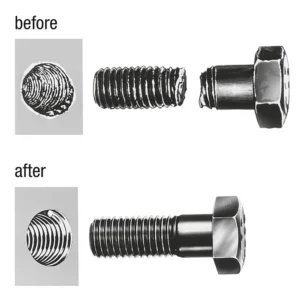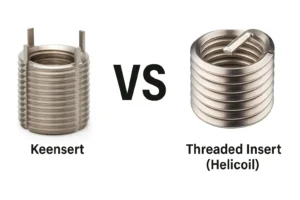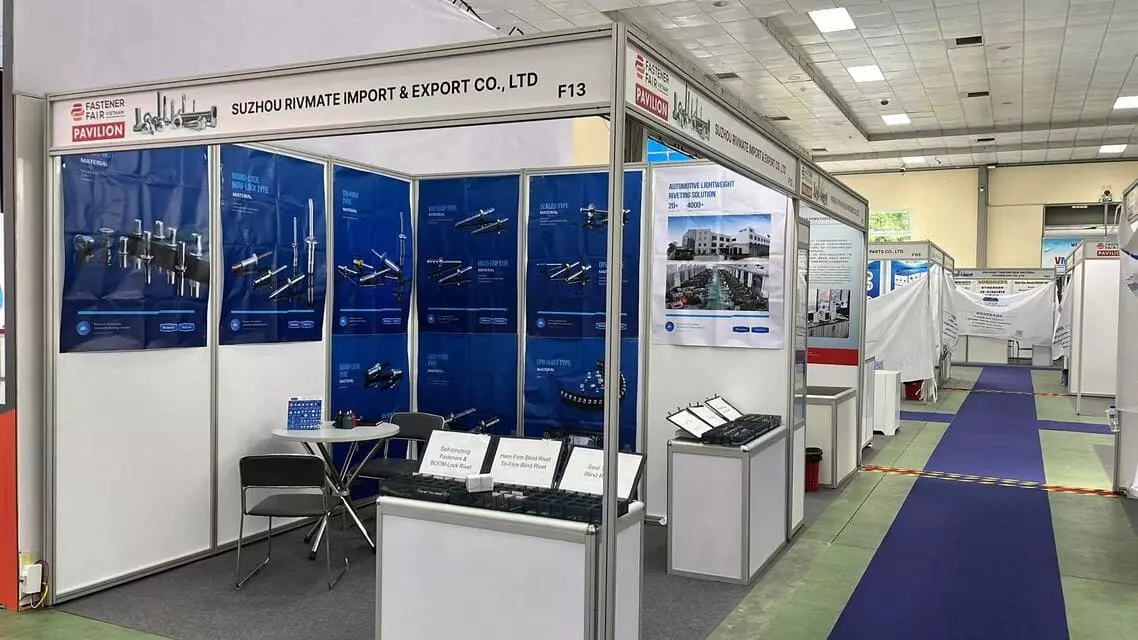How to Choose Threaded Inserts for Wood?
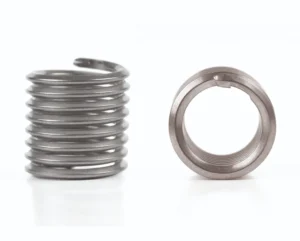
Leading Threaded Inserts Manufacturer and Supplier in China
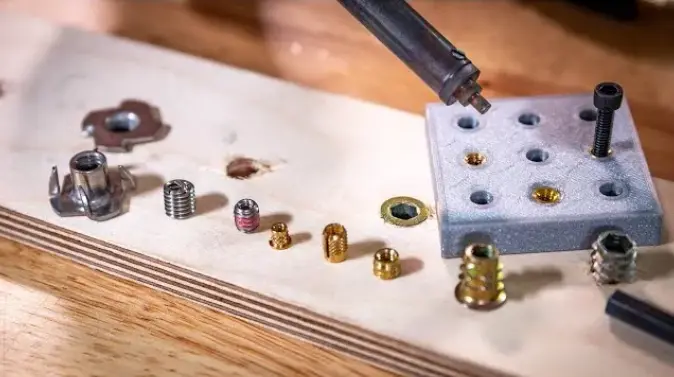
When working with wood, choosing the right fasteners is critical to ensuring long-term durability and ease of assembly. Threaded inserts for wood offer a reliable, professional-grade solution for creating strong, reusable connections—especially in projects that require precision, repeated disassembly, or high load capacity. In this guide, we’ll walk you through how to select the best type of threaded inserts for your wood application, based on material, load requirements, and installation methods.
Table of Contents
What Are Threaded Inserts for Wood?
Threaded Inserts for Wood are fastening elements embedded in wood with internal threads that provide strong, reusable threaded joints in wood substrates. They are commonly used in scenarios such as furniture assembly, woodworking, acoustic cabinets, musical instrument manufacturing, and outdoor wood structures to improve joint strength and extend thread life.
Wood is soft and abrasive, and direct tapping often results in loose or damaged threads. The introduction of threaded inserts avoids the problem of “slippage” and allows for a more robust screw connection, especially for applications that require multiple disassembly and reassembly or that carry large loads.
Common types of threaded inserts for wood include:
- Self-Tapping Inserts: Easy to install as they cut themselves into the wood through the external threaded structure.
- Hex/Cylindrical Press-in Inserts: rely on a shaped structure to press into wood holes, suitable for softwoods.
- Hammer-in Inserts: For quick installation scenarios where screwing is not required.
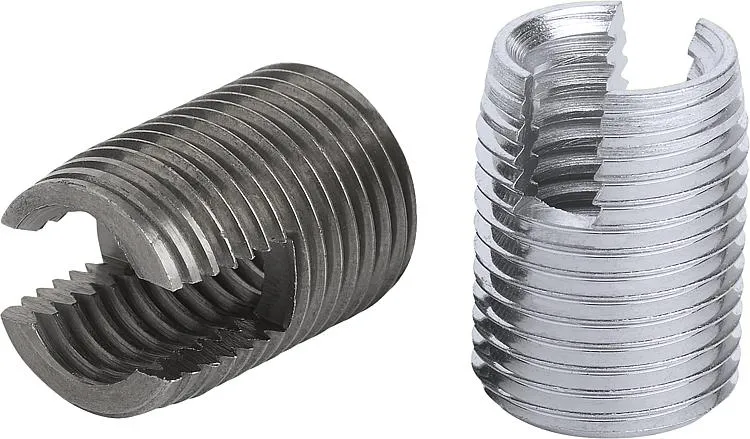
The use of threaded inserts not only improves the connection strength of the wood structure, but also enhances the structural stability and maintainability of the product, making them an indispensable connection solution in modern woodworking manufacturing.
Why Use Threaded Inserts in Wood Instead of Screws?
While traditional Wood Screws are widely used in woodworking and furniture manufacturing, Threaded Inserts are clearly superior when it comes to structural strength, repetitive disassembly, and long-term reliability.
①. Stronger resistance to pull-out force
Threaded Inserts are typically designed with a thickened male thread or self-tapping groove that securely “bites” into the fibrous tissue as it is screwed into the wood, creating a greater contact surface and friction than wood screws. This biting effect not only improves the strength of the connection, but also significantly enhances the resistance to pull-out, avoiding loosening or dislodging of the screw due to prolonged tension or external vibration. Especially in connection parts subject to tensile forces, such as suspension components, furniture pulls, machine bases, etc., the use of inserts provides a more secure and reliable fixing effect.
②. Multiple disassembly and reassembly is possible
Traditional wood screws constantly rub and damage the wood thread structure during screwing in and removal, especially in soft woods or particle boards, which tends to cause screw holes to enlarge, slip teeth, and ultimately make re-tightening impossible. Threaded inserts, on the other hand, utilize metal female threads that are highly resistant to abrasion and will not affect the solidity of the connection even with frequent disassembly and installation. This is especially important in products that require maintenance, upgrading or replacement of parts (e.g. furniture, audio equipment, industrial assemblies).
③. Preventing slippery teeth and wood breakage
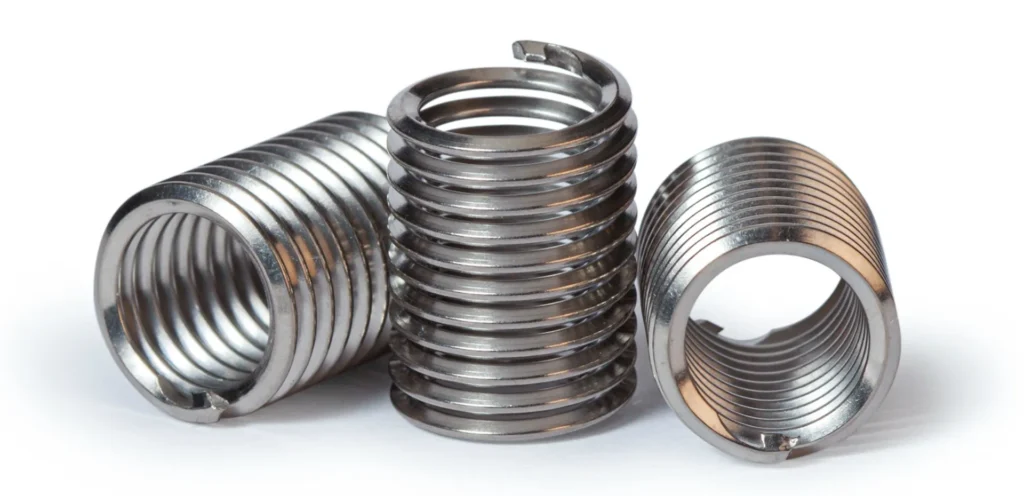
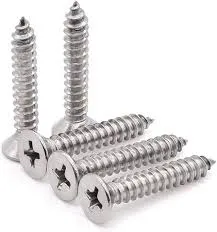
When the wood screws screwed directly into the wood, if the installation torque is too large or the density of the wood itself is not uniform, it is easy to lead to “slippery teeth” phenomenon, i.e., the screws are idle, the loss of fixed force. At the same time, wood may expand or contract with changes in temperature and humidity, increasing the risk of structural cracking. Threaded inserts significantly reduce the probability of wood damage and structural cracking by concentrating the stress on the engagement between the metal wall and the wood, effectively dispersing the installation force and the load generated during use.
④. Improve the strength and stability of the connection
When using screws in conjunction with inserts, the actual force structure is transformed into a “metal-to-metal” connection (screws are screwed into the internal metal threads of the inserts), whose tensile, shear, and seismic properties are superior to those of the traditional “screw-to-wood” connection. This structure is more adaptable to changes in loads and external shocks, and is less likely to be destabilized by loosening, making it particularly suitable for use in furniture frames, wall hangings or industrial equipment assemblies where loads are required.
⑤. Enhancement of product quality and professionalism
The use of threaded inserts is not only a reflection of structural optimization, but also a symbol of professional craftsmanship. In high-end wood products, customized furniture, and DIY advanced projects, precision positioning, hidden connections and repeated assembly through inserts can greatly enhance the overall assembly quality and product aesthetics. For end users, this structure is not only durable and reliable, but also conveys the brand’s attention to detail and craftsmanship.
Summary: Whether it’s for stronger tensile strength, long-term reuse, or to improve the overall quality of the product, threaded inserts are the preferred solution for wood structural connections. Particularly suitable for high loads, requiring disassembly and maintenance, or scenarios requiring high precision, they are a performance upgraded alternative to traditional wood screws.
What Types of Threaded Inserts Work Best in Wood?
a. Press-in Type
- Principle: Presses directly into pre-drilled holes manually or mechanically, relying on friction or ratchets for stability.
- Advantages:
- Quick and easy installation, no thread cutting required.
- Suitable for softwood (e.g. pine, plywood) and other materials that are easy to press.
- Disadvantages:
- Low pull-out and torsion resistance, not suitable for high strength connection occasions.
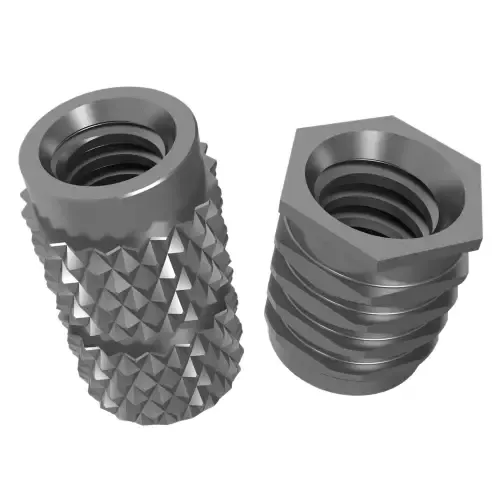
- Applicable Scenarios: Furniture assembly, low load occasions, processes requiring fast assembly.
b. Self-tapping type
- Principle: Inserts with sharp threads or cutting grooves on the outside that cut themselves to match threaded channels in the wood.
- Advantages:
- Provides greater bite and pull-out resistance.
- Reduces processing steps by eliminating the need for prior tapping.
- Disadvantages:
- Higher requirements for positioning accuracy during initial installation.
- Easy to crack wood during installation, need to pay attention to hole diameter control.
- Applicable Scenarios: Medium to high load requirements, especially widely used on solid or composite wood.
c. Hex drive type
- Principle: Screwed into pre-fabricated holes by means of a hexagonal wrench, commonly used for self-tapping inserts.
- Advantages:
- Easier to control installation and more concentrated torque.
- Prevents slippage or misalignment and improves consistency.
- Disadvantages:
- Slightly higher cost than common slot design.
- Suitable Scenarios: High assembly efficiency or woodworking projects requiring batch assembly.
d. Externally threaded vs. internally threaded
- Externally threaded type: The main purpose is to be fixed in the wood to provide support.
- Female threaded type: Inserts are left with threaded holes in the center for screws or bolts.
- Combination Description:
- Male thread provides structural anchorage;
- Female thread provides access for removable connection;
- Typical “external fixing and internal connection” structure.
- Combination of advantages: Improves connection strength and allows for repeated disassembly and reassembly, especially for parts requiring maintenance or replacement.
Form: Which Material Threaded Inserts Work Best in Wood?
| Material | Features | Applications |
|---|---|---|
| Brass | Strong corrosion resistance, good electrical conductivity, good decorative properties; low friction when installing, not easy to damage the wood | High-end furniture, electronics, decorative needs |
| Stainless steel | High strength, good weathering, corrosion resistance; but the processing of the hardness of the high cost | Outdoor assembly, humid environments, strong connection |
| Zinc Alloy | Low cost, good processing performance, commonly used in high-volume injection molding parts or economic inserts | Furniture manufacturing, one-time assembly parts |
How to Choose the Right Type of Threaded Insert for Wood?

1. Based on type of wood (hardwood vs. softwood)
1.1. hardwoods (e.g., oak, maple, walnut, birch)
- Characteristics:
- Dense fiber structure, high hardness, strong nail grip.
- Not easy to deform, but brittle, easy to crack due to stress concentration.
- Recommended Insert Type:
- Self-tapping Inserts: External threads have a cutting function and can be screwed directly into pre-drilled holes without tapping.
- Hex Drive Type: Allows for easy control of assembly torque and prevents inserts from being installed too deep or damaging the hole wall.
- Consider using stainless steel or brass to enhance connection strength and durability.
- Installation Recommendations:
- Must pre-drill pilot holes with a hole diameter slightly smaller than the outer diameter of the insert to avoid splitting wood.
- If the load is high, flange design is optional to increase the load area.
1.2. softwood (e.g., pine, cedar, plywood, medium fiberboard)
- Features:
- The wood is soft, weak nail grip, easy compression and deformation.
- It is easy to “eat air” or loose inserts during installation.
- Recommended insert type:
- Press-in Inserts (Press-in Inserts): with a serrated or ratcheted structure, relying on mechanical friction fixed.
- Large Pitch Self-Tapping Inserts: Increase holding power and prevent screw loosening.
- Priority is given to zinc alloy or brass for a smoother installation process and less wood damage.
- Installation Recommendations:
- Pre-hole size should be controlled, slightly smaller than the outer diameter of the insert to ensure stability after pressing in.
- For occasions with high load-bearing requirements, adhesives (such as woodworking adhesive or epoxy resin) can be used to assist in fixing.
2. Availability of mounting tools
- Availability of tapping tools or press fit equipment:
- If standard torque tools and tapping machines are available, finishing type inserts can be used for high installation accuracy.
- If only hand tools or portable electric drills are available, it is recommended to choose hexagonal self-tapping type inserts for easy positioning and driving.
- Bulk Assembly vs. Manual Assembly:
- For bulk use, special standard inserts can be used in conjunction with automatic nail feeding equipment.
- For manual assembly, it is recommended to use models with drive ports (e.g., Phillips, hexagonal, hexagonal hole types) for easy control of assembly torque.
3. Bearing Requirements: Tensile Strength / Shear Strength / Seismic Resistance
3.1. Pull-out Strength
Definition: The maximum load-bearing force, usually in Newtons (N) or kilograms of force (kgf), in a vertical direction, to attempt to pull a screw or insert out of wood.
Influencing Factors:
- Length of insert: the longer it is, the greater the contact area with the wood and the stronger the pulling force.
- Wood Density: Hardwoods provide greater tensile strength than softwoods. Example:
- Oak (density approx. 700 kg/m³): standard insert pulling force > 800 N;
- Pine (density approx. 450 kg/m³): same insert tension < 500 N.
- External thread construction: deeper teeth, wider pitch, barbed construction are more tensile.
Construction recommendations
- Use inserts with a length ≥ 1/2 of the material thickness (e.g. ≥ 10 mm inserts for 20 mm wood thickness);
- Add flange edge design to create a stop surface;
- Control of the pre-hole diameter: it is recommended that the pre-hole = 85-90% of the O.D. of the insert, to ensure adequate seating without splitting the wood;
- For loads > 1,000 N, it is recommended to use steel inserts + structural adhesive for fixing.
3.2 Shear Strength
Definition: The ability of an insert to resist lateral movement or breakage along the surface of the wood, commonly used in furniture joints, load-bearing pallets, and other transverse loading situations.
Influencing Factors:
- Insert Material and Wall Thickness: The shear force is mainly controlled by the strength of the metal:
- Stainless steel inserts (AISI 303): shear strength is about 250-350 MPa;
- Brass (C360): shear strength of approximately 150-200 MPa;
- Zinc alloy (ZAMAK 3): shear strength approx. 100-140 MPa.
- Connection structure design: single-point support vs. multi-point decentralized support.
- Wood thickness vs. laminate strength: extremely easy to shear or spall if too thin or incomplete laminate structure.
Structural Recommendations:
- For connections with shear loads >200 N:
- Use thick-walled inserts with reinforcing ribs;
- Use stainless steel or high-strength copper alloys;
- Use stainless steel or high-strength copper alloys. Add washers or reinforcing plates to distribute the stress;
- Screws of M6 or higher are recommended to increase the lateral resistance.
3.3. Seismic resistance / dynamic loading capacity
Definition: The ability of the connection to remain stable and not loosen under cyclic shocks such as equipment vibration, frequent mechanical movements, thermal expansion and contraction.
Risk manifestation
- Loosening of inserts, rotational disengagement;
- Loosening of screws leading to connection failure;
- Fatigue wear of threads and loss of bite.
Optimization solutions
- Structural type measures:
- Use self-locking inserts (interference locking teeth or nylon locking rings for internal threads);
- Match with elastic washers (e.g. spring washers, stop washers);
- If the environment temperature difference is severe, use low expansion coefficient metal (stainless steel is better than zinc alloy).
- Process type measures:
- Apply a preloading torque of approximately 70% of the yield strength of the screw during installation;
- Use threadlockers (e.g. Loctite 243 for metal-wood interfaces);
- Avoid the use of adhesive-type fixing for areas that are subject to repeated disassembly and reassembly.
Reference Data
| Application Scenario | Recommended Anti-Vibration Configuration | Design Pull-out Force (N) | Design Shear Force (N) |
|---|---|---|---|
| Speaker Enclosure Assembly | Self-locking brass insert + spring washer + wood glue | ≥600 | ≥300 |
| High-Speed Transport Pallet | Stainless steel insert + flange head screw + high-strength threadlocker | ≥1000 | ≥500 |
| Vibrating Machinery Mount | Thick-walled steel insert + interference-fit internal thread + retaining ring | ≥1500 | ≥800 |
4. Does it require removability or repeated installation
- Requires multiple removal/maintenance:
- Selecting internal thread type inserts (usually brass or stainless steel) will ensure that the screws are used repeatedly without damaging the wood body.
- Avoid press-in or glued-in inserts that are only suitable for one-time locking.
- No need to disassemble after fastening:
- Consider disposable press-in type, or lower cost zinc alloy inserts.
Where Are Threaded Inserts Most Useful in Woodworking?
1. Furniture assembly
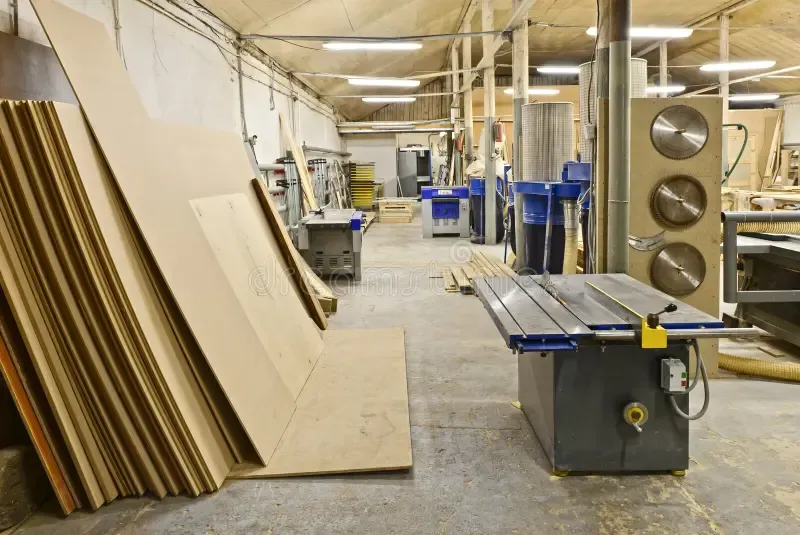
- Application Description: Commonly used in closets, bookcases, bed frames and other furniture structures that need to be assembled or disassembled on-site, connecting panels, reinforcing corners, hinge installation and other parts.
- Advantages Embodied:
- Provide detachable connection to avoid screws repeatedly screwed into the wood resulting in loosening;
- Improves overall structural stability and assembly consistency;
- Particularly suitable for KD structure (Knock-down) furniture, such as IKEA and other modular furniture.
2. Wooden chassis / equipment enclosures
- Application description: e.g. audio cases, router wooden shells, power tool housings, control panel frames etc.
- Advantages Embodiment:
- Repeated installation of screws will not damage the wood, suitable for maintenance or replacement of components;
- Works with metal screws or electrical grounding systems to enhance connection reliability;
- Vibration-resistant design enhances the stability of the equipment and prevents the screws from loosening during long-term use.
3. Home DIY / Woodworking Crafts
- Application Description: Mechanical connection or functional fixing in DIY projects such as homemade furniture, small decorative pieces, exhibit bases, etc.
- Advantages Embodied:
- Easy to install, compatible with commonly used hand tools;
- Neat appearance, enhancing the completion of the work;
- Supports screw removal for easy modification or upgrading of the structure.
4. Musical instruments or other high-precision wooden structures
- Application Description: Suitable for the assembly of guitars, amps, violins and other musical instruments with precise structures that need to be adjusted and maintained, or for wooden fixtures, positioning seats, precision guides and other occasions.
- Advantages Embodied:
- Avoid damage to wood threads due to repeated assembly, maintain intonation or structural accuracy;
- Can be used for hidden fastening or micro-adjustable construction;
- Brass or stainless steel inserts provide high texture and oxidation resistance, in line with high-end product positioning.
FAQ: Choosing and Using Threaded Inserts in Wood
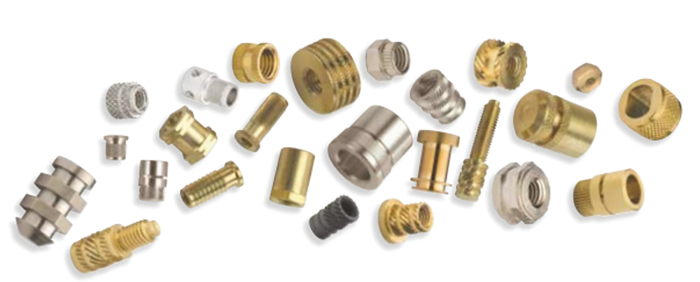
① Can Threaded Inserts be used in Plywood or MDF?
Yes. Plywood and MDF are uniform in structure and are suitable for use with Press-in or Self-Tapping Inserts.
- Pre-drill appropriate hole sizes** before installation to avoid delamination or board blowout;
- Give preference to wide pitch design to improve grip;
- For low-density medium-fiber boards, it is recommended to use structural adhesive to assist fixing to enhance the pulling force.
② What if the wood cracks during installation?
Most of the wood cracking is caused by improper pre-hole size or excessive installation torque. Treatment recommendations are as follows:
- Pre-drilled holes should be sized at 85-90% of the insert OD;
- Use a hex drive tool to ensure an even torque;
- When installing in hardwood, reduce friction by first applying a small amount of lubricant (e.g. paraffin oil);
- If the wood is cracked, fill with epoxy and redrill, or replace the location and reinstall.
③ Which material inserts are the most corrosion resistant?
- Stainless steel inserts (e.g. A2-304 or A4-316) have the best corrosion resistance and are suitable for use in outdoor or wet environments;
- Brass inserts are highly resistant to oxidation and are suitable for indoor long-term use;
- Zinc alloy inserts low cost, general corrosion resistance, not recommended for structures exposed to air or water vapor.
If there are seashore, industrial gases, high humidity occasions, should be preferred to use A4 grade stainless steel inserts.
④ Can it be disassembled and reassembled repeatedly? Will the threads wear out?
- The use of internally threaded metal inserts significantly improves the life of repeated disassembly and reassembly;
- Brass or stainless steel materials can be tightened more than 1000 times under normal use without damage to the threads;
- If ordinary wood screws are used to screw directly into the wood, the threads are very prone to wear and loosening.
Therefore, high-frequency loading and unloading structure (such as chassis, access doors, furniture connectors) is strongly recommended to use inserts.
⑤ Can an insert be repaired if it comes loose?
Yes, specific repair methods include:
- Re-fixing with structural adhesive: fill the hole with high-strength adhesive (e.g., epoxy adhesive) after cleaning the residue in the hole, and then press in the insert;
- Enlarge the hole diameter to reassemble: choose a larger OD model to reopen the hole for installation;
- Nested repair: embed small inserts into large inserts (for high precision repair);
- In the case of soft wood, replacing the mounting position may be a more reliable way.
Do You Have Any Questions?
Let Us Solve Your Problem
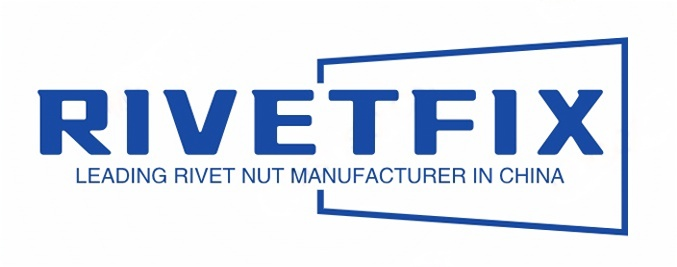
Whether you’re a furniture maker, an equipment assembly engineer, or a woodworking enthusiast looking for high standards, Rivetfix threaded inserts are the most reliable choice for your connecting structures. We offer solutions in brass, stainless steel, zinc alloys, and a wide range of substrates including hardwoods, softwoods, and laminates, ensuring industrial-grade stability and durability every time you tighten.
👉 Choose Rivetfix today and make connections worry-free!
Contact us for samples, engineering support or customized solutions.
Get High Quality Rivet Nuts Quote!
Send Your Rivet Nut Request
For more than 20 years, Rivetfix has helped customers solve many rivet nuts sourcing needs and technical challenges.
Have a question? Contact us and we’ll provide you with the perfect solution.

